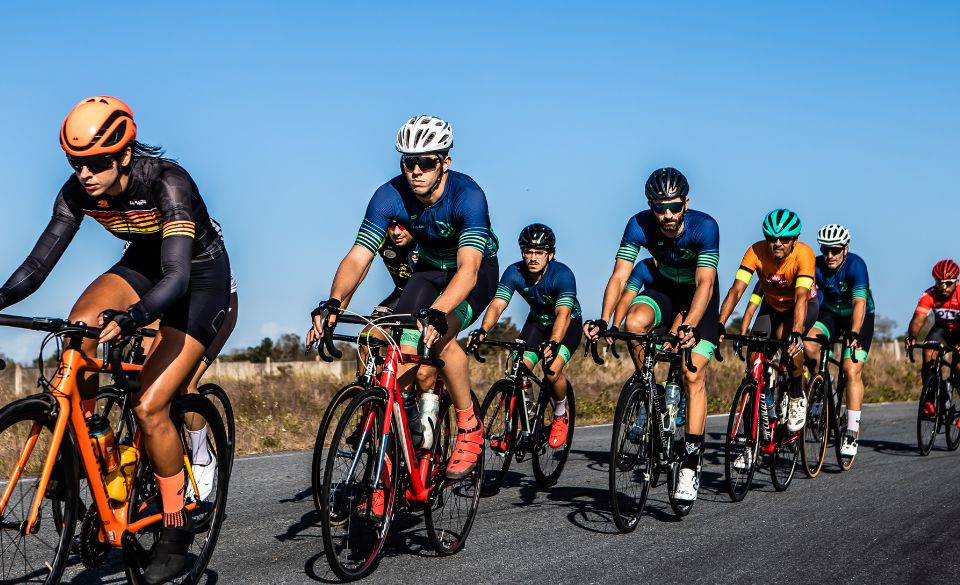
Do Strong Glutes Help Cycling? A Complete Guide
Page Contents
Cycling is an incredible cardiovascular exercise that engages various muscle groups, but have you ever wondered if strong glutes (the muscles in your buttocks) play a crucial role in cycling performance? The answer is a resounding yes! In this article, we’ll explore the significance of strong glutes in cycling, the benefits they bring to your ride, and how you can strengthen these powerhouse muscles to enhance your cycling experience.
The Importance of Strong Glutes in Cycling
Cycling, often celebrated for its graceful fluidity and seemingly effortless gliding, conceals a powerhouse of muscle engagement beneath the surface. At the center of this hidden dynamo lies a group of muscles that quietly but decisively shape your cycling prowess—the glutes. Yes, those often underestimated buttock muscles are your uncelebrated heroes on the saddle.
Imagine your glutes as the engine of a finely-tuned machine, propelling you forward with every pedal stroke. These muscles, specifically the gluteus maximus, are the primary drivers of power generation in cycling. As you press down on the pedals, it’s the formidable gluteus maximus that contracts, transferring energy from your body into the bike’s propulsion. In essence, stronger glutes translate into a more formidable engine, enabling you to conquer hills, sprint to the finish line, and maintain higher speeds with grace and efficiency.
But the role of the glutes extends far beyond raw power. Cycling demands a delicate equilibrium of balance and stability, especially when navigating treacherous terrain or sharp turns. Here, your glutes join forces with your core muscles to maintain posture and steadiness on the saddle. The gluteus medius, a smaller yet crucial glute muscle, plays a pivotal role in stabilizing your pelvis, ensuring it remains steadfast during dynamic lateral movements.
Furthermore, the health of your glutes bears direct consequences on injury prevention. Weak glutes can lead to muscular imbalances, a recipe for overuse injuries such as knee discomfort or the notorious iliotibial band syndrome (ITBS). To prevent these setbacks, it’s essential to maintain well-conditioned glutes. By distributing the workload evenly among your leg muscles, strong glutes minimize the risk of imbalances and injuries, allowing you to revel in the freedom of cycling with confidence.
1. Power Generation
Strong glutes are essential for generating power during each pedal stroke. As you push down on the pedals, your gluteus maximus—the largest muscle in your glutes—contracts to drive the pedals and propel you forward. The stronger your glutes, the more force you can exert on the pedals, translating to increased speed and efficiency.
2. Stability and Balance
Cycling requires balance and stability, especially when navigating challenging terrain or making tight turns. Your glutes, along with your core muscles, help you maintain proper posture and stability on the saddle. A strong gluteus medius, one of the smaller glute muscles, aids in stabilizing your pelvis and preventing excessive side-to-side movement.
3. Injury Prevention
Weak glutes can lead to imbalances in your leg muscles, which may increase the risk of overuse injuries, such as knee pain or iliotibial band syndrome (ITBS). Strengthening your glutes can help distribute the workload more evenly among your leg muscles, reducing the risk of injury.
The Benefits of Strong Glutes for Cyclists
Cycling, a symphony of movement and endurance, relies on the harmonious interplay of various muscle groups to propel you forward. Among these, the glutes, a powerful trio of muscles in your buttocks, take center stage as unsung heroes of your cycling journey. Let’s delve into the myriad benefits that strong glutes bring to your cycling experience, from conquering challenging terrain to achieving faster speeds.
1. Hill-Crushing Prowess
Picture yourself ascending a steep hill on your bike, legs working tirelessly against gravity. Here’s where strong glutes come into play as your secret weapon. The gluteus maximus, the largest muscle in your gluteal group, flexes with formidable strength during each pedal stroke, enabling you to conquer inclines with confidence. As you push down on the pedals, these powerful muscles generate the force needed to propel you upward, turning daunting climbs into conquerable challenges.
2. Speed and Acceleration
Whether you’re racing against the clock or simply aiming to enjoy a swift, exhilarating ride, strong glutes can be your ticket to higher speeds and quicker accelerations. The gluteus maximus, with its capacity for generating power, allows you to apply greater force to the pedals. As a result, your bike responds with bursts of speed, whether you’re sprinting to the finish line or overtaking fellow cyclists. Strong glutes enable you to tap into your untapped velocity, making for a thrilling and dynamic ride.
3. Endurance Amplification
Long-distance cycling necessitates enduring strength, a quality in which strong glutes excel. These muscles facilitate sustained, efficient pedaling by stabilizing your pelvis and maintaining proper form. As you pedal mile after mile, the endurance of your glutes ensures you can maintain a consistent cadence and distribute the workload evenly among your leg muscles. This means you can cycle for extended periods without succumbing to early fatigue, allowing you to explore new horizons and embark on memorable cycling adventures.
4. Comfort in the Saddle
Comfort is paramount when it comes to cycling, and strong glutes play a pivotal role in enhancing your riding experience. A well-conditioned gluteus medius, one of the smaller glute muscles, contributes to pelvic stability. This stability minimizes undesirable side-to-side movements on the saddle, reducing the risk of discomfort, chafing, or saddle sores. With strong glutes supporting your pelvis, you can focus on the joy of the ride without being distracted by discomfort or pain.
5. Injury Prevention
Weak glutes can lead to muscular imbalances in your legs, potentially paving the way for overuse injuries. Conditions like iliotibial band syndrome (ITBS) or knee pain may arise when glutes fail to share the workload effectively. By strengthening your glutes, you mitigate the risk of these injuries, promoting a long and injury-free cycling journey.
How to Strengthen Your Glutes for Cycling
1. Squats: The Foundational Exercise
Squats are the cornerstone of glute strengthening exercises. They engage your gluteus maximus, the largest muscle in your gluteal group, with unrivaled intensity. When performing squats, ensure your form is impeccable: feet shoulder-width apart, chest lifted, and knees tracking over your toes. Begin with body weight squats and progress to incorporate weights for added resistance. Squats not only target your glutes but also work your quadriceps and hamstrings, providing comprehensive lower-body strength.
2. Lunges: Unilateral Strength Builders
Lunges are superb for isolating and strengthening your glutes, especially the gluteus medius, which plays a pivotal role in stabilizing your pelvis during cycling. Forward, reverse, and lateral lunges all work different areas of your glutes, ensuring balanced development. Execute lunges with precision by taking a step forward or backward, bending your front knee to a 90-degree angle, and keeping your core engaged. As you progress, you can incorporate dumbbells or a barbell to intensify the exercise.
3. Deadlifts: A Compound Powerhouse
Deadlifts, a compound exercise, engage multiple muscle groups, including your glutes, lower back, and hamstrings. To perform deadlifts effectively, begin with your feet hip-width apart, grasp the barbell with an overhand grip, and hinge at your hips while keeping your back straight. As you lift the barbell, engage your glutes and drive your hips forward. Deadlifts are a fantastic way to boost the power of your glutes while promoting overall lower-body strength.
4. Glute Bridges: Isolation for Maximum Activation
Glute bridges specifically target your gluteus maximus, making them a superb isolation exercise. Lie on your back with your knees bent, feet flat on the ground, and arms at your sides. Raise your hips toward the ceiling, squeezing your glutes at the top of the movement. Lower your hips back down and repeat. To add difficulty, perform single-leg glute bridges or place a resistance band around your thighs.
Remember that proper form is essential when performing these exercises to ensure you’re effectively targeting your glutes without risking injury. Start with a weight or resistance level that challenges you but allows you to maintain proper technique.
Studies Confirm the Impact
Several studies have delved into the relationship between glute strength and cycling performance. A study published in the “Journal of Strength and Conditioning Research” found that cyclists with greater gluteus maximus muscle activation exhibited improved pedal force during a cycling test. Another study in the “Journal of Sports Science & Medicine” concluded that strengthening the gluteus maximus can positively impact sprint cycling performance.
Cycling, a symphony of motion and endurance, relies on the harmonious coordination of various muscle groups. Amidst this complex interplay, the glutes emerge as a silent but powerful conductor, orchestrating the efficiency and power of your pedal stroke. Let’s delve into the remarkable ways in which strong glutes transform your pedal stroke into a symphony of motion.
How Strong Glutes Help Your Pedal Stroke
Imagine your glutes as the power plant of your cycling performance. At the heart of this powerhouse is the gluteus maximus—the largest muscle in your glutes. As you press down on the pedals, this mighty muscle contracts with astonishing force, transferring energy from your body into your bike’s propulsion system. Think of it as a piston in an engine, driving each pedal stroke with vigor and purpose.
Strong glutes are essential for generating the power that moves you forward, especially when faced with challenging terrains or steep inclines. When you need to conquer a hill, accelerate, or maintain high speeds, it’s your gluteus maximus that responds with the necessary force. It’s your secret weapon for surmounting the most demanding cycling obstacles.
Efficiency and Fluidity
Strong glutes are not just about raw power; they are also the architects of an efficient and fluid pedal stroke. The gluteus maximus’s strength allows you to exert more force on the pedals, ensuring that each stroke propels you forward with less wasted energy. As a result, your pedal stroke becomes a seamless, rhythmic motion, akin to a well-rehearsed performance by a skilled orchestra.
In addition to power generation, your glutes play a pivotal role in maintaining your body’s stability and balance on the saddle. Proper posture and stability are crucial, particularly when navigating uneven terrain or executing tight turns. Here, your glutes collaborate with your core muscles, ensuring that you maintain equilibrium and control. This partnership between your glutes and core creates a symphony of balance and grace that makes your ride smoother and more enjoyable.
The Cadence Maestros
Strong glutes also contribute to your ability to maintain a consistent cadence—a crucial aspect of efficient cycling. A stable and controlled pedal stroke stems from the strength of your glutes. With each pedal revolution, your glutes powerfully engage, allowing you to maintain the desired cadence with precision. This ability to control your pedal stroke rhythmically enhances your cycling performance, whether you’re cruising at a steady pace or pushing yourself to reach higher speeds.
Final Words – Do Strong Glutes Help Cycling?
Strong glutes undoubtedly play a pivotal role in cycling performance. They provide the power, stability, and endurance needed to excel on the bike while reducing the risk of injuries and enhancing overall comfort. Incorporating glute-strengthening exercises into your training routine can make a significant difference in your cycling journey. So, whether you’re a seasoned cyclist or just starting, don’t neglect your glutes—they might just be the secret weapon you need for a smoother, faster, and more enjoyable ride.



